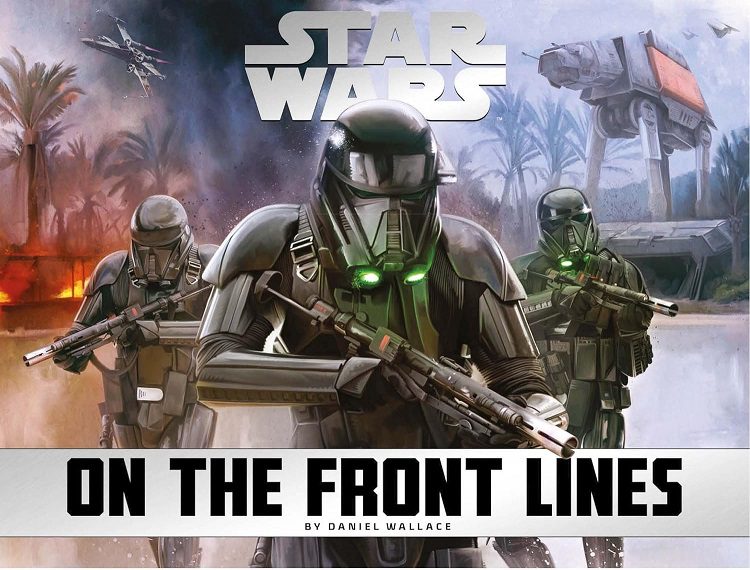
The Star Wars universe is defined by conflict. Whether it’s the internal struggle of a young Jedi finding his way in the world while dealing with some pretty heavy family baggage or a ragtag group of rogues trying to pass along some top secret plans, there’s always a lot of fighting going on in these stories. With Star Wars: On the Front Lines, author Daniel Wallace offers fans a unique perspective on eleven pivotal battles from the Star Wars chronology.
Starting with the Battle of Naboo and taking us all the way through the attack on Starkiller Base, Wallace uses descriptive storytelling and tactical analysis to put the reader … well, on the front lines. The title is apt, to say the least. Covering areas from the Clone Wars animated series and Star Wars films, hardcore fans will no doubt be familiar with each of the military operations depicted in this book but even the most casual fan will recognize the major events, like the Battle of Hoth or the skirmish that took place on the forest moon of Endor. Regardless of your personal position in Star Wars fandom, you’ll find a new level of depth is brought to each story in this book through first-person retellings and beautiful illustrations.
Basically, each chapter is dominated by an overview of the battle – the political and social events that led to or surrounded it, the status of the war at the time, and the major players involved. From there, we get a brief bio of the leaders of each side, helping us to understand their position in their respective side and the mindset that guided them through each conflict. And that’s where the book gets really interesting. On the Front Lines also offers us a look at the combatants and weaponry utilized in each battle, accompanied by images of ships, guns, droids, and troops. A subsection titled “Tales of Valor” focuses on one particular combatant and finally, there are the first-person retellings of what really went down.
These were my favorite parts of the book. I mean, the nerdy tech and weapon stuff was really cool because obviously everyone loves spaceships and robots and stuff, but the “I Was There” sections really offer the most insight into the Star Wars universe because they aren’t told from the perspective of Luke Skywalker, Han Solo, or even Wedge Antilles (though Nien Nunb does offer a scintillating retelling of his part in the Battle of Endor). These are stories told by the grunts and the engine workers, the pilots and the survivors who nearly became casualties of war. These tales take an exciting science fiction/fantasy encounter and humanize it by showing readers the horrors of war and its aftermath much in the same way the Clone Wars series or Rogue One did. It’s not all fairy tales about laser swords and royal lineage, you know? For the adults reading this book, it’s a layer of depth that elevates the realism of the story and deepens your connection to it. For the kids, it may serve as a learning lesson that war isn’t all about glory and adventure.
In addition, the lengthy descriptions of each battle offer insight into the overall Star Wars story. They’re well written and feel more like a historical archive than fan fiction. Without beating a long dead horse, the prequel trilogy is… often not as compelling as the original trilogy (or the entire rest of the Star Wars canon, for that matter) and as a result, the events in each film can be a bit obtuse and difficult to fully understand. Wallace’s explanations of each conflict and the occurrences that led to it smooth out some of those rough spots and give more detail on why each battle took place and what the heck the whole thing was about anyway. The inclusion of conflicts from beyond the scope of the six core films function the same way, expanding on what we know and fleshing out what we don’t in order to give a stronger and more cohesive narrative to the entire Star Wars saga.
My only negative comment on the book is that I’m not entirely sure who painted all of these great pictures. Brian Rood and Fares Maese are credited with the front and back of the jacket and Sam Dawson is given a jacket design credit, but I’m not 100% if these are the same folks who did the stuff on the inside. Maybe I just missed something, but I couldn’t find any real credits – and credit is definitely due. From the portrait style paintings of Grand Moff Tarkin or Obi-Wan Kenobi to the beautiful two page spreads depicting more action than the silver screen could contain, the artwork in this book is really something to behold. There’s also some stuff that kinda looks like the stock Star Wars images you might see on wrapping paper or tablecloths, run through that Prisma app that everybody downloaded last year. Those are really cool too.
It’s not too often that something comes along that makes Star Wars better, but I’m comfortable putting Star Wars: On the Front Lines in that category. I would definitely recommend it and suggest it as a gift for any Star Wars fan in your life this holiday season.